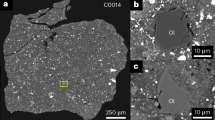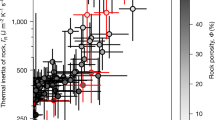Abstract
The Earth accretes about 30,000 tons of dust particles per year, with sizes in the range of 20–400 µm (refs 1, 2). Those particles collected at the Earth's surface—termed micrometeorites—are similar in chemistry and mineralogy to hydrated, porous meteorites3,4,5,6,7, but such meteorites comprise only 2.8% of recovered falls8. This large difference in relative abundances has been attributed to ‘filtering’ by the Earth's atmosphere9, that is, the porous meteorites are considered to be so friable that they do not survive the impact with the atmosphere. Here we report shock-recovery experiments on two porous meteorites, one of which is hydrated and the other is anhydrous. The application of shock to the hydrated meteorite reduces it to minute particles and explosive expansion results upon release of the pressure, through a much broader range of pressures than for the anhydrous meteorite. Our results indicate that hydrated asteroids will produce dust particles during collisions at a much higher rate than anhydrous asteroids, which explains the different relative abundances of the hydrated material in micrometeorites and meteorites: the abundances are established before contact with the Earth's atmosphere.
This is a preview of subscription content, access via your institution
Access options
Subscribe to this journal
Receive 51 print issues and online access
$199.00 per year
only $3.90 per issue
Buy this article
- Purchase on Springer Link
- Instant access to full article PDF
Prices may be subject to local taxes which are calculated during checkout




Similar content being viewed by others
References
Love, S. G. & Brownlee, D. E. A direct measurement of the terrestrial mass accretion rate of cosmic dust. Science 262, 550–553 (1993)
Taylor, S., Lever, J. H. & Harvey, R. P. Accretion rate of cosmic spherules measured at the South Pole. Nature 392, 899–903 (1998)
Kurat, G., Koeberl, C., Presper, T., Brandstätter, F. & Maurette, M. Petrology and geochemistry of Antarctic micrometeorites. Geochim. Cosmochim. Acta 58, 3879–3904 (1994)
Brownlee, D. E., Bates, B. & Schramm, L. The elemental composition of stony cosmic spherules. Meteorit. Planet. Sci. 32, 157–175 (1997)
Genge, M. J., Grady, M. M. & Hutchison, R. The textures and compositions of fine-grained Antarctic micrometeorites: Implications for comparisons with meteorites. Geochim. Cosmochim. Acta 61, 5149–5162 (1997)
Engrand, C. & Maurette, M. Carbonaceous micrometeorites from Antarctica. Meteorit. Planet. Sci. 33, 565–580 (1998)
Nakamura, T., Noguchi, T., Yada, T., Nakamuta, Y. & Takaoka, N. Bulk mineralogy of individual micrometeorites determined by X-ray diffraction analysis and transmission electron microscopy. Geochim. Cosmochim. Acta 65, 4385–4397 (2001)
Sears, D. W. G. & Dodd, R. T. in Meteorites and the Early Solar System (eds Kerridge, J. F. & Mathews, M. S.) 3–31 (Univ. Arizona Press, Tucson, 1988)
Baldwin, B. & Sheaffer, Y. Ablation and breakup of large meteoroids during atmospheric entry. J. Geophys. Res. 76, 4653–4668 (1971)
McSween, H. Y. Alteration in CM carbonaceous chondrites inferred from modal and chemical variations in matrix. Geochim. Cosmochim. Acta 43, 1761–1770 (1979)
McSween, H. Y. Petrographic variations among carbonaceous chondrites of the Vigarano type. Geochim. Cosmochim. Acta 41, 1777–1790 (1977)
Fuchs, L. H., Olsen, E. & Jensen, K. J. Mineralogy, mineral chemistry, and composition of the Murchison (C2) meteorite. Smithson. Contrib. Earth Sci. 10, 1–39 (1973)
Corrigan, C. M. et al. The porosity and permeability of chondritic meteorites and interplanetary dust particles. Meteorit. Planet. Sci. 32, 509–515 (1997)
Noguchi, T. & Nakamura, T. Mineralogy of Antarctic micrometeorites recovered from the Dome Fuji Station. Antarct. Meteorite Res. 13, 285–301 (2000)
Greshake, A. et al. Heating experiments simulating atmospheric entry heating of micrometeorites: clues to their parent body sources. Meteorit. Planet. Sci. 33, 267–290 (1998)
Jessberger, E. K. et al. in Interplanetary Dust (eds Grün, E., Gustafson, B. A. S., Dermott, S. F. & Fechtig, H.) 253–294 (Springer, Heidelberg, 2001)
Toppani, A., Libourel, G., Engrand, C. & Maurette, M. Experimental simulation of atmospheric entry of micrometeorites. Meteorit. Planet. Sci. 36, 1377–1396 (2001)
Schaal, R. B., Hörz, F., Thompson, T. D. & Bauer, J. F. Shock metamorphism of granulated lunar basalt. Proc. Lunar Planet. Sci. Conf. 10, 2547–2571 (1979)
Kieffer, S. W. Shock metamorphism of the Coconino sandstone at Meteor Crater, Arizona. J. Geophys. Res. 76, 5449–5473 (1971)
Schmitt, R. T. Shock experiments with the H6 chondrite Kernouvé: Pressure calibration of microscopic shock effects. Meteorit. Planet. Sci. 35, 545–560 (2000)
Gaffey, M. J., Bell, J. F. & Cruikshank, D. P. in Asteroids II (eds Binzel, R. P., Gehrels, T. & Matthews, M. S.) 98–127 (Univ. Arizona Press, Tucson, 1989)
Jones, T. D., Lebofsky, L. A., Lewis, J. S. & Marley, M. S. The composition and origin of the C, P, and D asteroids: water as a tracer of thermal evolution in the outer belt. Icarus 88, 172–192 (1990)
Housen, K. R., Holsapple, K. A. & Voss, M. E. Compaction as the origin of the unusual craters on the asteroid Mathilde. Nature 402, 155–157 (1999)
Scott, E. R. D., Keil, K. & Stöffler, D. Shock metamorphism of carbonaceous chondrites. Geochim. Cosmochim. Acta 56, 4281–4293 (1992)
Stöffler, D., Keil, K. & Scott, E. R. D. Shock metamorphism of ordinary chondrites. Geochim. Cosmochim. Acta 55, 3845–3967 (1991)
Zolensky, M. E., Weisberg, M. K., Buchanan, P. C. & Mittlefehldt, D. W. Mineralogy of carbonaceous chondrite clasts in HED achondrites and the Moon. Meteorit. Planet. Sci. 31, 518–537 (1996)
Sears, D. W. G. The case for chondrules and CAI being rare in the early solar system: Some implications for astrophysical models (abstract). Lunar Planet. Sci. 28, 1273–1274 (1997)
Flynn, G. J. Atmospheric entry heating: A criterion to distinguish between asteroidal and cometary sources of interplanetary dust. Icarus 77, 287–310 (1989)
Love, S. G. & Brownlee, D. E. Heating and thermal transformation of micrometeoroids entering the Earth's atmosphere. Icarus 89, 26–43 (1991)
Tomeoka, K., Yamahana, Y. & Sekine, T. Experimental shock metamorphism of the Murchison CM carbonaceous chondrite. Geochim. Cosmochim. Acta 63, 3683–3703 (1999)
Acknowledgements
We thank T. Hiroi, L. P. Keller and T. Mukai for discussions. We acknowledge support by a Grant-in-Aid from the Ministry of Education, Science and Culture, Japan, and a grant from the Japan Society for the Promotion of Science.
Author information
Authors and Affiliations
Corresponding author
Ethics declarations
Competing interests
The authors declare that they have no competing financial interests.
Rights and permissions
About this article
Cite this article
Tomeoka, K., Kiriyama, K., Nakamura, K. et al. Interplanetary dust from the explosive dispersal of hydrated asteroids by impacts. Nature 423, 60–62 (2003). https://doi.org/10.1038/nature01567
Received:
Accepted:
Issue Date:
DOI: https://doi.org/10.1038/nature01567
This article is cited by
-
A history of mild shocks experienced by the regolith particles on hydrated asteroid Ryugu
Nature Astronomy (2023)
-
Collisional formation of top-shaped asteroids and implications for the origins of Ryugu and Bennu
Nature Communications (2020)
-
Characterization of Environmental Dust in the Dammam Area and Mud After-Effects on Bisphenol-A Polycarbonate Sheets
Scientific Reports (2016)
-
Seasonal variations in Dustfall and its iron content over North China
Advances in Atmospheric Sciences (2008)
-
Dust Production from the Hypervelocity Impact Disruption of Hydrated Targets
Earth, Moon, and Planets (2005)
Comments
By submitting a comment you agree to abide by our Terms and Community Guidelines. If you find something abusive or that does not comply with our terms or guidelines please flag it as inappropriate.



